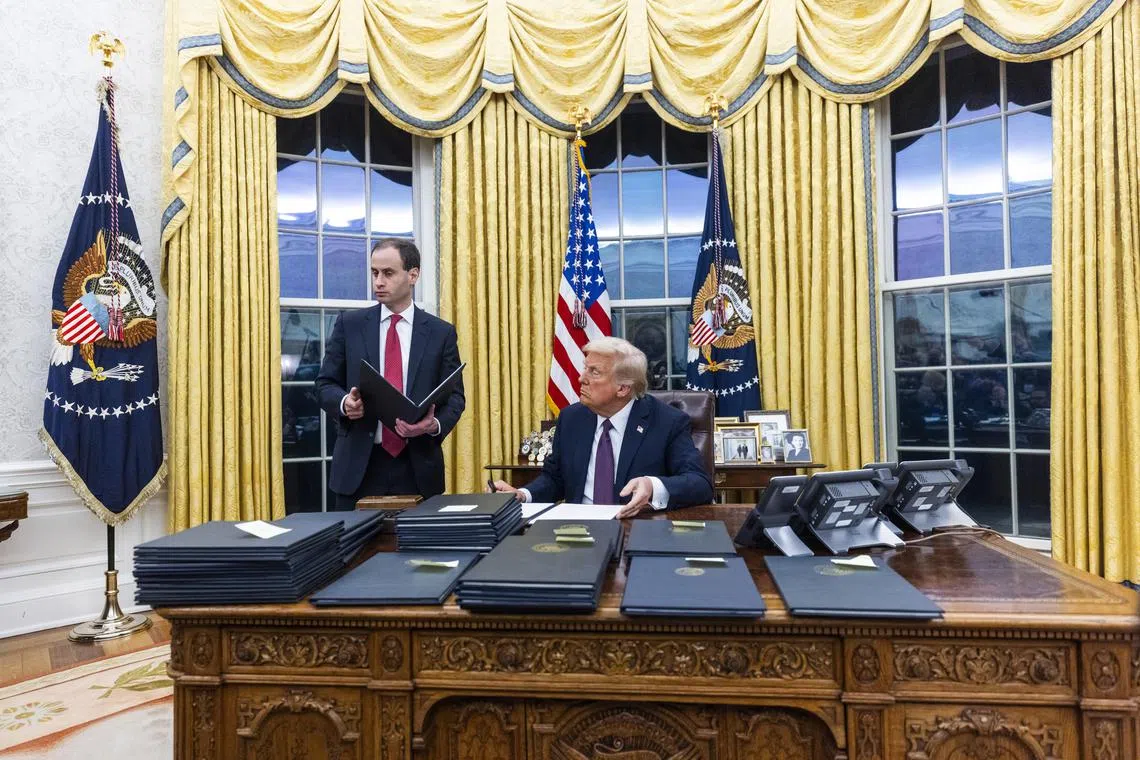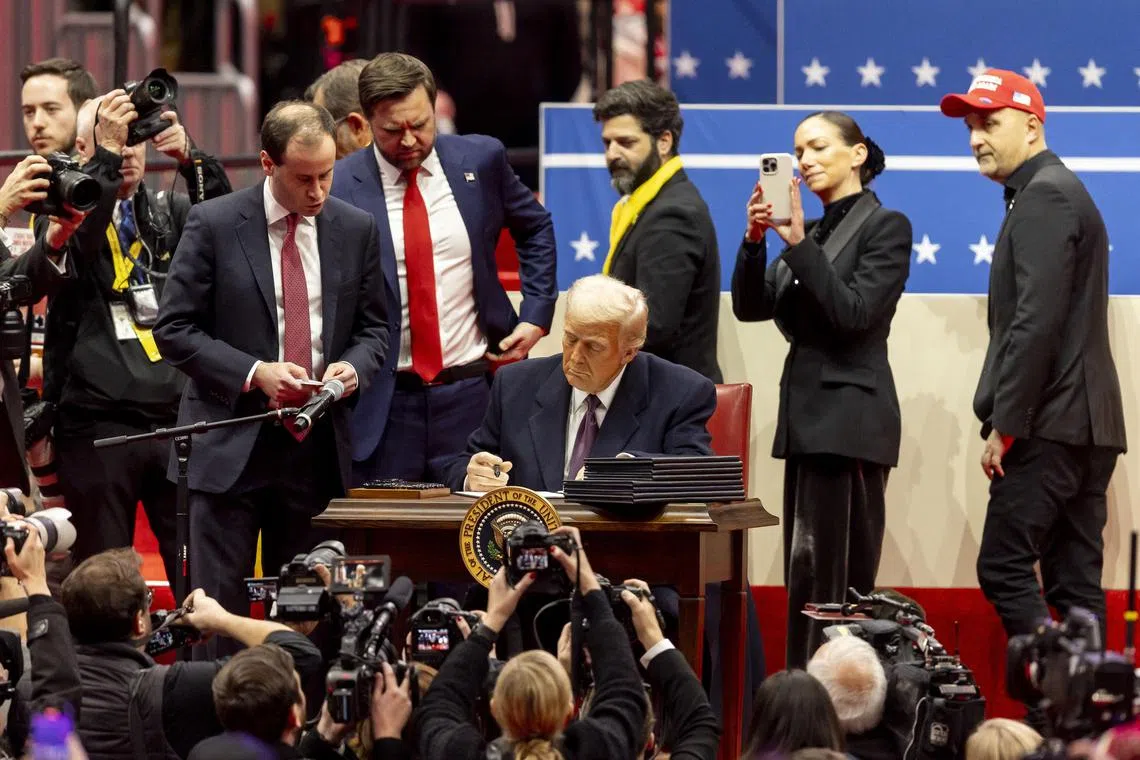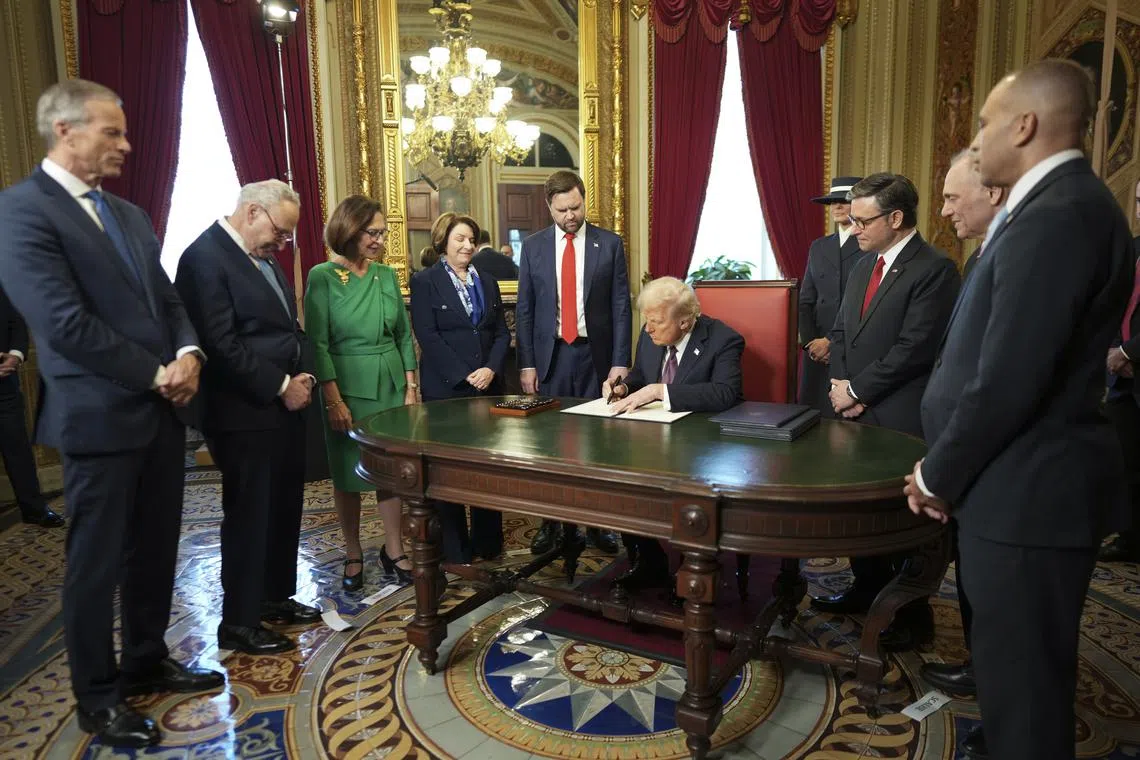News analysis
Trump’s tariff tease: Not just yet, but threats loom
Sign up now: Get ST's newsletters delivered to your inbox

Mr Donald Trump’s second term got off to a blistering start on Jan 20, with 42 executive orders aimed at reshaping America.
PHOTO: EPA-EFE
Follow topic:
WASHINGTON – To the surprise of many, newly inaugurated President Donald Trump’s flurry of day one announcements
He made no move to impose across-the-board tariffs, nor did he sign off on selective punitive action on certain sectors or countries as he had repeatedly threatened to do during his election campaign.
But in an impromptu press conference while signing off on wide-ranging executive orders, he suggested he might consider using tariffs as leverage to push his policies.
In the case of China, the tariffs might be used to get Beijing on board with a deal to okay the divestiture of Chinese stakeholding in the popular short-video app TikTok.
On Canada and Mexico, he said 25 per cent tariffs could be in the offing as early as Feb 1
For the European Union (EU), he invoked tariffs to balance the trade.
“They don’t take our cars, they don’t take our farm products, they don’t take almost anything,” said Mr Trump, in reference to US trade with the EU.
“And yet, we take their cars and we take their farm products, we take a lot from them. So we’ll figure that out with either tariffs or they have to buy our oil.”
In sum, Mr Trump’s second term got off to a blistering start on Jan 20, with 42 executive orders aimed at recasting America in line with his Make America Great Again agenda.
Probably the most predictable yet shocking decisions were his withdrawal of the US from the World Health Organisation and, for the second time, from the Paris climate accord that aims to curb global warming.
The most consequential to his campaign promise of making America safe and affordable again might be the declaration of two national emergencies.
One allows for the deploying of troops at the southern border to stop illegal immigration, and the other trims regulations to allow unbridled oil and gas drilling.
The most political act, undoubtedly, was pardoning about 1,500 people
And the most popular might be his decision to order a 75-day halt on the enforcement of a ban on TikTok,
The pause, he said, might allow for a deal that would enable the app to comply with a 2024 law, which demands that it trade its Chinese parent company ByteDance for an American one. TikTok has suggested that a stake sale would be difficult, and China has barred the export of the algorithm that accounts for the app’s success – without which it might not attract a US investor.
“I think ultimately (Beijing) would approve it because we’d put tariffs on China,” Mr Trump said as he signed off on his promised reprieve for TikTok.
“I’m not saying I would, but you certainly could do that.”
The flurry of executive orders came at the end of a long day, which began with Mr Trump’s 30-minute inaugural address after taking the oath of office at noon.
Within minutes, he vowed to turn the page on the policies of his predecessor, Mr Biden, which he said brought on “decline” in the country.
The US would no longer be “taken advantage” of, Mr Trump declared, and promised an immediate “overhaul of our trade system” that he said would include tariffs and taxes on foreign countries.
“For this purpose, we are establishing the External Revenue Service to collect all tariffs, duties and revenues,” he said, adding that it would result in “massive amounts of money pouring into our Treasury from foreign sources”.
For nations keenly watching for the new US tariff policy, this was a broad hint as to what lies ahead in the most talked-about feature of his administration.
“The absence of expected announcements of tariff hikes comes as a surprise, particularly in the light of the series of tariff threats issued by the incoming President on the campaign trail,” said Ms Wendy Cutler, vice-president of the Asia Society Policy Institute and former acting deputy US trade representative.
“It seems to suggest a division within the Trump team on the most appropriate scope, timing and targets for the tariff hikes,” she said.
“While this is good news for our trading partners for now, it should not be interpreted as the administration backing off its tariff pledges.”

US President Donald Trump signing a series of executive actions on stage during a presidential inaugural event in Washington on Jan 20.
PHOTO: EPA-EFE
As part of his mission to make America “respected” again, Mr Trump proposed renaming the Gulf of Mexico the Gulf of America. Even more controversially, he announced he would officially pursue retaking control of the Panama Canal.
The US paid for the construction of the canal more than a century ago. Former president Jimmy Carter agreed to hand it over to Panama, which took full control of the waterway in 1999.
“We have been treated very badly from this foolish gift that should have never been made, and Panama’s promise to us has been broken,” Mr Trump said in his speech. He repeated concerns that he had aired in the lead-up to his inauguration that China had undue influence over the canal.
“China is operating the Panama Canal, and we didn’t give it to China. We gave it to Panama, and we’re taking it back,” he said.
Is that really possible, given Panama’s flat rejection of the idea?
US Secretary of State Marco Rubio said at his confirmation hearing last week that the US could justifiably make the case that Panama had violated the treaty that put it in charge of the waterway.
Beijing did not have direct control of the canal, Mr Rubio said, but he warned that the canal was susceptible to Chinese influence and could turn into a choke point during a conflict.
Mr Trump also laid the groundwork for a sprawling crackdown on illegal immigrants,
The most effective of the measures might be his decision to reinstate the “Remain in Mexico” policy of his first term. This allows migrants to stay in northern Mexican border cities while US courts process their applications.
Resuming the construction of the border wall with Mexico will go down well with millions of Trump supporters, but most analysts consider it to be of limited utility.

US President Donald Trump during a signing ceremony after his inauguration as the 47th president at the Capitol in Washington.
PHOTO: DOUG MILLS/NYTIMES
Somewhat controversially, Mr Trump also ordered a change to withhold birthright citizenship from children born to illegal immigrants. But such a change requires amending the Constitution and will most likely attract legal challenges.
His energy-related executive orders enable the federal government to slash permitting requirements for energy projects, speed up power plant construction and boost fossil fuel exports.
However, while the oil sector welcomes the relaxation of regulations, it may be constrained in raising its output, as the US is already producing record volumes of oil and natural gas.
Houston-based energy expert Carl Larry said the changes made sense, considering that many of the government initiatives for wind and solar energy were loss-making.
“These days we have plenty of oil supply, but as we see growth in natural-gas-for-power demand, the US strength lies in our ability to supply LNG (liquefied natural gas),” he said, adding that he expected to see export restrictions on LNG lifted.
Tariffs and political partnerships are going to shape the oil industry, Mr Larry said. “LNG could be that trade lever for many of the countries under examination for tariffs, including Canada and Mexico.”
Bhagyashree Garekar is The Straits Times’ US bureau chief. Her previous key roles were as the newspaper’s foreign editor (2020-2023) and as its US correspondent during the Bush and Obama administrations.


